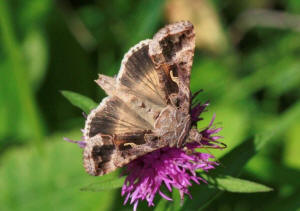|
Swat team: scientists track humongous
number of flying bugs
 Send a link to a friend
Send a link to a friend
 [December 26, 2016]
By Will Dunham [December 26, 2016]
By Will Dunham
WASHINGTON (Reuters) - Counting the number
of bugs whizzing high overhead annually may seem all but impossible, but
researchers in Britain have completed the most comprehensive tally ever
conducted. And the headcount they came up with was almost
un-bee-lievable.
A total of 3.5 trillion insects weighing a combined 3,200 tons annually
migrated annually over a region in south-central England monitored with
specialized radar and a balloon-supported aerial netting system, the
scientists said on Thursday.
"High-altitude aerial migration of insects is enormous," said University
of Exeter entomologist Jason Chapman, whose research was published in
the journal Science. "These aerial flows are an unappreciated aspect of
terrestrial ecosystems, equivalent to the oceanic movements of plankton
which power the oceanic food chains."
The researchers tracked the migration of insects at altitudes between
492 feet and 3,937 feet (150-1,200-meters) over a 10-year period. They
suspect even more migrating bugs could be found elsewhere.
"The numbers will be considerably higher in most parts of the world, but
we lack the data to extrapolate the total numbers yet," Chapman said.

In terms of biomass, the insects greatly exceeded migratory birds in
Britain. Their biomass was seven times that of the 30 million songbirds
flying from Britain to Africa each autumn.
While the study did not plot the departure and destination points for
the migrating bugs, they were thought to be traveling back and forth
numerous miles (km), and sometimes over the English Channel and North
Sea.
"Some of the butterflies and moths we studied migrate hundreds of
kilometers (miles) in each generation, and thousands of kilometers
(miles) over the course of the year, which may include six generations,"
Chapman said.
Insects play important roles, pollinating plants, facilitating
productive soil through decomposing, serving as food sources for birds
and bats, spreading disease, and serving both as crop pests and
predators of crop pests.
[to top of second column] |

The silver Y moth (Autographa gamma), pictured, is a major component
of the large night-flying insect migrants studied by radar in the
new study, measuring migration annually over a region in
south-central England monitored with specialized radar and a
balloon-supported aerial netting system, scientists said, December
22, 2016. Ian Woiwod/Handout via REUTERS

"We could not function without them," Chapman said.
The mass insect migrations generally headed north in spring and
south in autumn.
The most abundant day-flying insects in the study included cereal
aphids and the tiny parasitoid wasps that attack them. The most
abundant medium-sized day-flying insects included hoverflies and
ladybirds, also called ladybugs, and the most common big ones
included large butterflies such as the painted lady.
At night, abundant small insects included midges and other flies,
while medium-sized ones includes lacewings and large ones included
noctuid moths and hawkmoths.
(Reporting by Will Dunham)
[© 2016 Thomson Reuters. All rights
reserved.]
Copyright 2016 Reuters. All rights reserved. This material may not be published,
broadcast, rewritten or redistributed.
 |